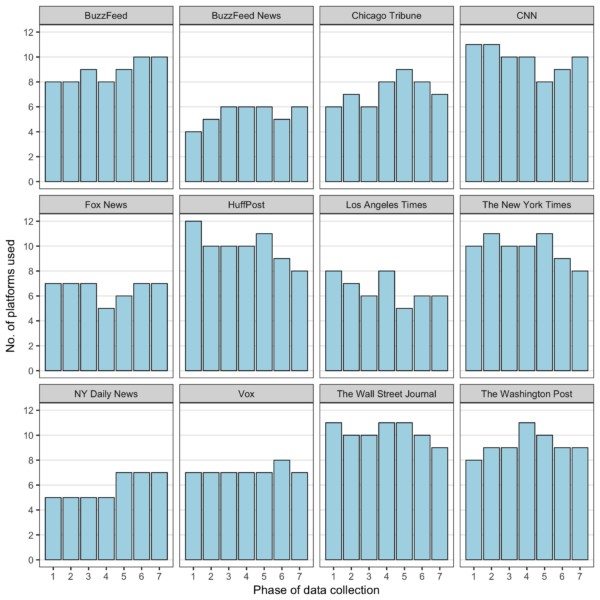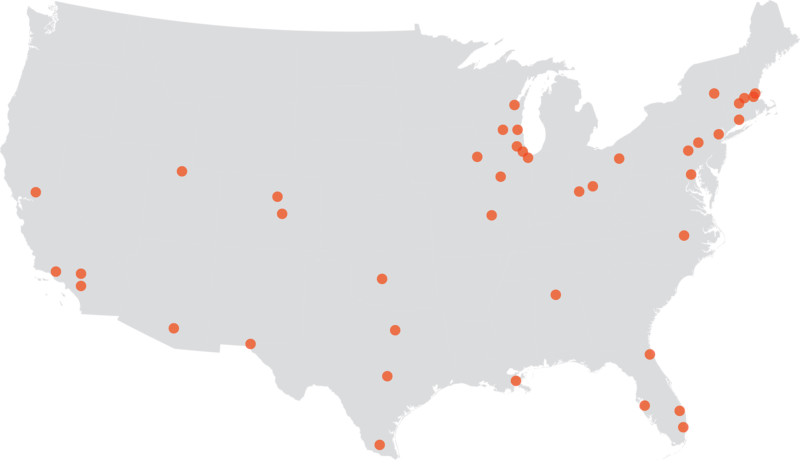The relationship between platforms and the press, use of tablets among children and teens, media M&A activity, who makes up the editor roster at the largest U.S. newspapers, and more are covered in this installment of TFP’s Media Metrics roundup.
To help you keep up with trends and prepare for changes just around the corner, every quarter we compile excerpts from some key reports covering issues affecting the publishing and media industries. Here are our top picks.
 Friend and Foe: The Platform Press at the Heart of Journalism (Tow Center)
Friend and Foe: The Platform Press at the Heart of Journalism (Tow Center)
- A survey of more than 1,100 journalists found that most newsrooms have aligned their practices to social platforms, but 86% of respondents said social has led to a lack of trust in journalism.
- Some 50% of respondents said Facebook and other social platforms have enhanced the relationship journalists have with their audience, while 22% believe it has weakened it.
- A majority of respondents (76%) believe Facebook is falling short when it comes to addressing fake news and misinformation on its platform. A smaller percentage said the same about Twitter (71%) and Google (65%).
38% of U.S. Children and Teens Read on Their Tablet (Good E-Reader)
- In the U.S., 65% of children and teens 8 to 17 years old use tablets every day—and most have complete ownership of their device vs. using their parents’ device.
- Tablet usage is highest (74%) among younger children ages 8 to 11, although 67% of those 12 to 14 years old and 52% of teens 15 to 17 years old report that they use tablets “frequently.”
- Among children and teens, the most popular activities on tablets is watching videos and music, but 38% also use them to read e-books.
Media M&A Forecast to Hit Well Over $140 Billion (Digital News Daily)
- There were 950 mergers and acquisitions in media, information, marketing, software, and tech services in the first half of 2018, more than the full-year activity in both 2016 and 2017.
- M&A activity in the first half of 2018—excluding the Time Warner and 21st Century Fox deals—totaled approximately $140 billion.
- While transaction volume in that period was down compared with earlier years, transaction value was up sharply, increasing 43%.
Who’s the Boss (Columbia Journalism Review) 
- Nearly a third of the editors at 135 of the largest English-language newspapers in the U.S. “have an advanced degree, and they attended private high schools at nearly twice the national rate,” according to a CJR report.
- However, at least 5 of the 135 editors didn’t finish college, and 1 in 3 editors are local, meaning they work at newspapers near or in the same city in which they either grew up (each dot on the map shows a major newspaper whose editor went to high school within 150 miles of it).
- Other stats from the report: 73% are male; 9 in 10 are white; 60% have a journalism degree; and 7% went to an Ivy League school.
Editorial Salaries Decline Amid Industry Instability (Folio)
- There’s been a 14% decline in the median annual base salary for magazine editors in 2018, according to the most recent salary survey by Folio. That figure has gone from $86,000 to $74,000 this year.
- However, editorial employees who have worked in the industry for more than 20 years have a higher median total compensation: $89,000, or 68% more than those with less than 10 years of experience.
- Salaries are also higher for employees who work 50-plus hours a week. In 2018, those employees earned 48% more than those who worked fewer than 40 hours per week.
After Years of Growth, the Use of Social Media for News Is Falling Across the World (Nieman Lab)
- The 2018 Reuters Institute Digital News Report shows use of social media as a source for news is down, especially on Facebook: Only 39% of survey respondents said they get their news from the platform, a drop of 9 percentage points from 2017.
- In the same period, there’s been an even steeper decline among younger respondents, with a 20% drop in the percentage of those who use Facebook for news.
- According to the research, there’s been an uptick in use of messaging apps like WhatsApp for news sharing. Although only 4% of U.S. users get their news from the app, its use globally has almost tripled since 2014.
Content Marketing Surges, Tops $16 Billion Worldwide (Research Intelligencer)
- Content marketing has grown into a $7 billion market in the U.S. and a $16 billion business worldwide, according to recent research, “reflecting a strategic push by marketers to bypass conventional advertising and media buying.”
- The report notes so-called branded entertainment has been growing “at about twice the rate of general advertising and marketing.”
Most Americans Think Big Tech Should Be Regulated Like Big Banks (Recode)
- A recent survey shows 53% of Americans think big technology companies like Google and Facebook should be regulated by the government, similar to how large banks are.
- However, 38% of respondents said they aren’t confident that the federal government is capabile of regulating tech giants.
- The report says a majority of Americans (62%) agree that one way or another, “the government will take steps to regulate the tech sector within the next few years.”
Forecast: Netflix Could Grow to Nearly 90 Million Subs In 12 Years (Television News Daily)
- A research company projects that Netflix will grow to 87 million subscribers by 2030. The digital video company currently has 57 million users in the U.S.
- Most of the new users are likely to be “today’s younger TV-video consumers,” the report says, noting “an estimated 80 million U.S. adults have the Internet but do not have Netflix, and many of them are young.”
- Of survey respondents 18 to 49 years old, 82% already have access to Netflix, it says. In comparison, 44% of adults 50 to 64 and 22% of those 65 or older have Netflix.
AI Use Is Growing, But Data Challenges Remain: Study (Email Marketing Daily)
- A recent study found that 64% of brands expect to increase their use of artifical intelligence for email marketing this year, while 36% say their AI usage will stay the same.
- Use cases include audience expansion (43%), audience targeting (39%), product recommendations (28%), and campaign optimization (26%).
- However, “only 6% conduct personalization, using collaborative filtering and predictive models. And a mere 16% segment customers by predictive affinities,” the report says.
- Some 46% of study participants said they are using at least 50% of their customer data for their campaigns, while 54% are using less.
Graphics: Tow Center/CJR
Media Metrics is a monthly feature from Technology for Publishing, aimed at keeping you armed with the latest industry data. If you’d like to share something you’ve read, drop us a note. And keep up with the latest industry news coverage by signing up for our This Week in Publishing emails and our Publishing Innovations newsletter.
Posted by: Margot Knorr Mancini


